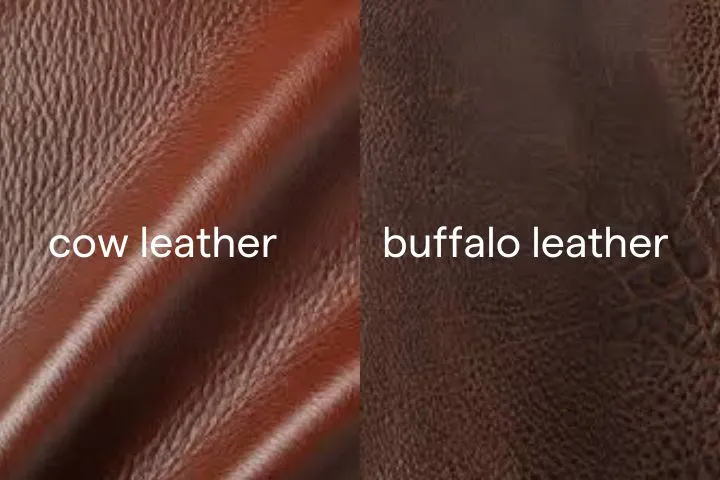What Is Pebbled Leather And Is It Real Leather
Pebbled leather is a textured finish made by tumbling hides or embossing a pebble pattern; it may be real leather or synthetic. The term describes the surface, not the species.
Choose full grain for strength and patina, top grain for uniformity, corrected grain for cost, or synthetic for stain control and tight visual repeat.
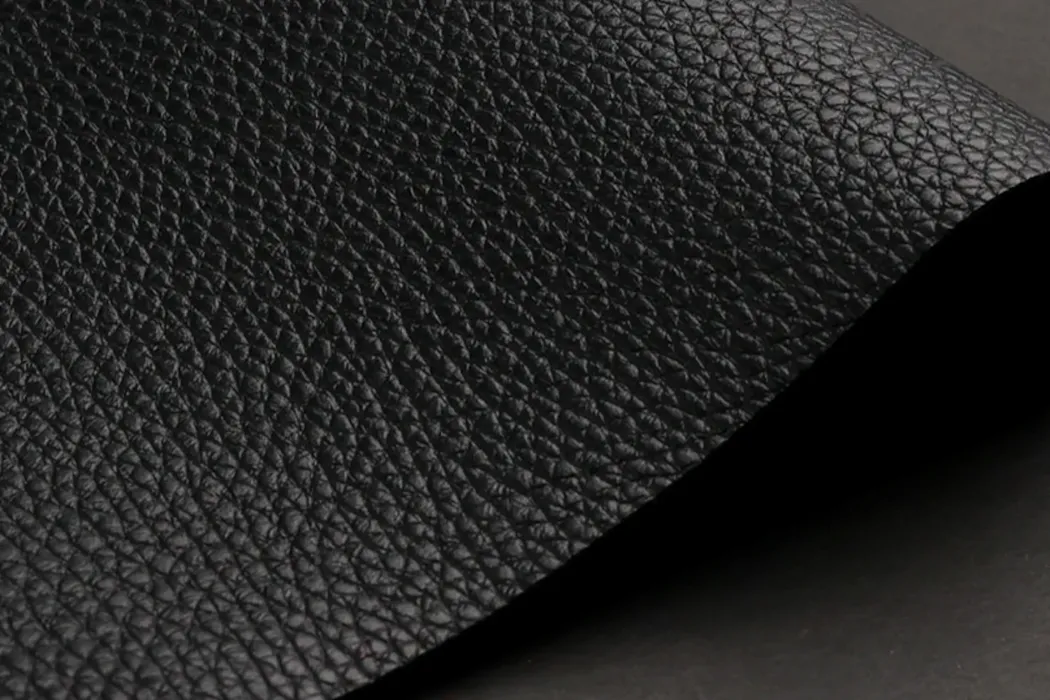
The Pebble Texture And How It Is Created
- Tumbled grain: Drums agitate hides 30–180 minutes at ~35–45°C; moisture 12–18% for soft lift.
- Embossed grain: Plates or rollers at 80–120°C and 20–60 bar press uniform pebbles; 6–20 s dwell.
- Hybrid routes: Light tumble then emboss for natural hand with consistent matching.
- Performance note: Textured panels show 20–40% fewer visible scuffs than smooth controls.
Full Grain Top Grain And Corrected Grain As Base Materials
- Full grain: Highest fiber strength; typical bag-panel tear targets ≥ 25–35 N.
- Top grain: Slight correction; targets ≥ 18–28 N with cleaner look.
- Corrected grain or split: Heavy coat; common targets ≥ 12–22 N for SLGs.
- Note: Edge and stitch quality can outweigh base grade in real-world failures.
Real Pebbled Leather Versus PU And Microfiber Lookalikes
- Real leather: Breathable and repairable; water vapor permeability often ≥ 800–1500 g/m²·24h.
- PU or microfiber: Very uniform; plan for hydrolysis stability ≥ 3–7 days accelerated.
- Identify: Random pores, fibrous back, warm edge burnish hint real leather.
- Lifecycle: Real leather accepts restoration; synthetics are harder to repair after film failure.
| Base material | How pebbled | Breathability | Patina potential | Tear target (bag panels) | Typical price band | Common uses |
|---|---|---|---|---|---|---|
| Full grain | Tumbled or light emboss | High | Strong | ≥ 25–35 N | $$$ | Luxury bags, belts, wallets |
| Top grain | Emboss or tumble + finish | Medium | Moderate | ≥ 18–28 N | $$ | Premium mass programs |
| Corrected split | Heavy emboss + coat | Low | Low | ≥ 12–22 N | $ | Entry lines, SLGs |
| PU or microfiber | Embossed sheet | Low | None | Design-dependent | $ | Cost-focused programs |
Pebbled is a finish. You can have real pebbled leather, corrected pebbled leather, or a synthetic with a pebble look. Choose the base to fit the job.
Are There Different Types And Grades Of Pebbled Leather
Yes—types vary by base (full grain, top grain, split, synthetic) and by pebble method (tumbled or embossed).
Grades reflect hide selection, defect density, coating level, and pattern control, which shift hand feel, durability, logo clarity, yield, and price.
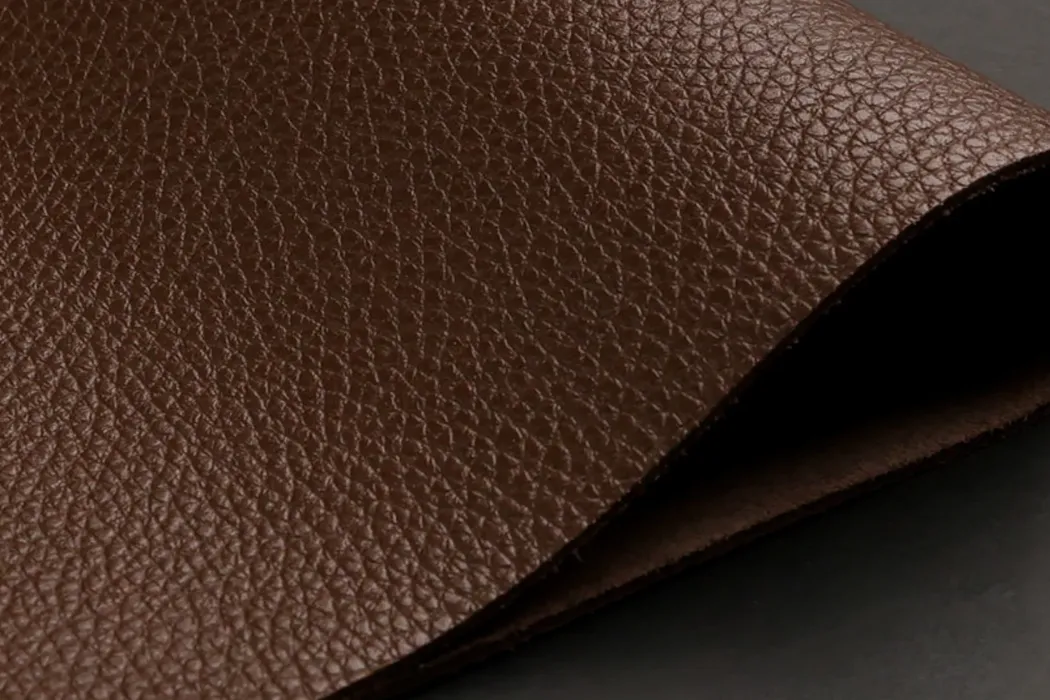
Natural Pebbled Versus Embossed Patterns And When To Choose Each
- Natural pebbled: Softer hand; pattern variance ±5–15% across panels is normal.
- Embossed: Pattern variance often held within ±2–4% with stable temps and good plates.
- Cutting yield: Uniform emboss can raise yield by 2–6% versus high-variance tumble lots.
- Decision rule: Natural for story and touch; emboss for scaling and tight matching.
Grades And Quality Tiers Including Full Grain Top Grain Split And Coated Variants
- Prime full grain: Lower defect density; sorting reject rate often < 5–8%.
- Standard top grain: Reject rate 8–12%; light correction improves surface.
- Corrected split heavy coat: Reject rate 3–6% due to cover-up.
- Coated variants: Crocking targets: Dry ≥ 4/5, Wet ≥ 3–4/5 (grey scale).
Pebble Size Depth Density And Pattern Uniformity And Their Visual And Tactile Effects
- Fine pebble: 0.5–1.0 mm pitch; SLG-friendly and logo crisp.
- Medium pebble: 1.0–1.8 mm; balanced grip and structure for bags.
- Large pebble: 1.8–2.8 mm; casual look, strong scuff masking.
- Depth: 0.15–0.45 mm typical; deeper patterns need solid edge systems.
How Types And Grades Influence Cost Durability And Branding Clarity
- Upgrading split to top grain can raise material cost 20–40% but increase tear by 30–70%.
- Fine pebble improves foil edge sharpness by 10–20% in QC grading.
- Heavier coats cut breathability by 50%+ yet reduce stain complaints.
- Emboss plate sharing across styles can save $0.05–$0.20 per unit at volume.
| Type or grade | Visual cues | Durability trend | Branding suitability | Cost impact | Typical applications |
|---|---|---|---|---|---|
| Prime full grain natural pebble | Soft depth, slight variance | ★★★★★ | Deboss and metal excel | High | Luxury bags and belts |
| Top grain embossed | Even pattern, stable color | ★★★★☆ | Foil and print register well | Medium | Premium mass handbags |
| Corrected split heavy coat | Uniform, semi-matte to gloss | ★★★☆☆ | Foil stable; small deboss may fill | Low | SLGs and entry belts |
| PU or microfiber embossed | Consistent pebble, no pores | ★★☆☆☆ | Print clean; foil adhesion varies | Lowest | Cost-focused programs |
How Is Pebbled Leather Made And Which Process Is Better
Makers either tumble hides to lift natural grain or emboss a pebble with heat and pressure. Tumbling gives soft character and story; embossing gives consistency, faster matching, and better yield. The “better” method is the one that meets your hand feel, throughput, and cost targets.
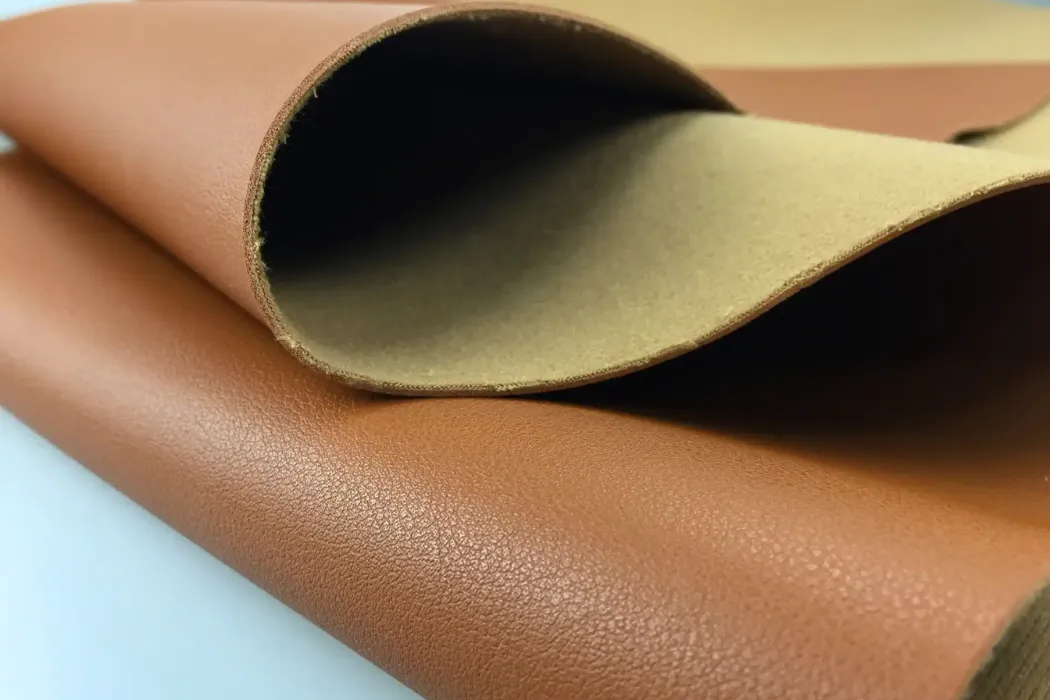
Drum Tumbling To Raise The Natural Grain
- Cycle: 30–180 minutes per batch; longer cycle, deeper relief, more variance.
- Moisture: 12–18%; too dry cracks, too wet blurs peaks.
- Perceived softness can rise 10–25% vs un-tumbled controls.
- Yield can drop 1–3% compared with tight emboss lines.
Roller And Plate Embossing For Consistent Pebble Patterns
- Process window: 80–120°C, 20–60 bar, 6–20 s dwell, finish-dependent.
- Pattern drift held to ±2–4% with quality tooling and stable heats.
- Panel matching time falls 15–30%, raising throughput.
- Shared plates reduce per-unit cost after tooling is amortized.
Dye Pigment And Topcoat Stacks And Their Effects On Look And Care
- Aniline: Rich grain, lower stain resistance; many accept Dry 4/5, Wet 3/5.
- Semi-aniline: Thin pigment adds protection; keeps hand.
- Pigmented: Strong color control; breathability can drop 50–70% vs aniline.
- Topcoat: Typical gloss 10–25 GU for daily bags; higher gloss cleans easier but shows touch-ups.
Process Selection Tradeoffs For Uniformity Yield And Cost
- Tumbled for luxury lines; accept more sorting and variance.
- Emboss for mass programs; gain matching speed and yield.
- Coat level balances stain claims vs breathability and patina.
- QC: lock temperature and pressure windows to cut batch drift.
| Method | Consistency | Throughput | Cost | Durability trend | Patina trend | Typical use cases |
|---|---|---|---|---|---|---|
| Tumbled | Medium | Medium | High | High | Strong | Luxury bags and belts |
| Embossed | High | High | Medium | High | Moderate | Premium mass programs |
| Heavily coated embossed | Very high | High | Low–Medium | High stain resistance | Low | Entry lines, SLGs, travel |
How Durable Is Pebbled Leather And What Factors Influence Longevity
Pebbled leather wears well because texture hides light scuffs. True life depends on base grain, tannage, thickness, and build. Edges, linings, stitches, and hardware often decide failure points—treat them as part of your durability plan.
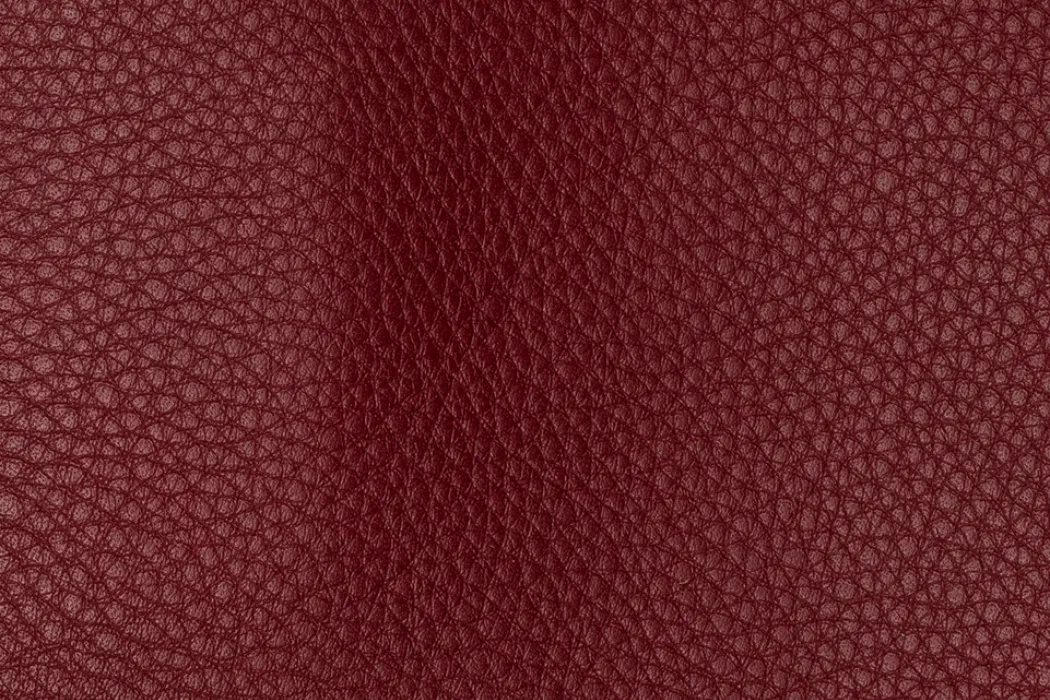
Grain Selection Tannage And Thickness As Core Variables
- Grain: Full grain can raise tear and tensile by 25–60% vs split at equal thickness.
- Tannage: Chrome = soft flex; veg = body. Combo tannages mix traits.
- Thickness: Belts 3.2–3.6 mm; bag panels 1.4–2.2 mm.
- Finish impact: Heavy coats add stain resistance yet slow patina and breathability.
Edge Construction Linings And Hardware As Typical Failure Points
- Edge paint: aim for ≥ 5k–8k flex cycles without crack.
- Lining stretch mismatch can raise seam stress 15–30%.
- Hardware plating: fashion lines use ≥ 0.2–0.4 μm; bump up for heavy-use straps.
- Stitch pitch 3.0–3.5 mm balances strength and look on textured panels.
Pebbled Versus Smooth In Scratch Hiding And Patina Development
- Textured surfaces show 20–40% fewer visible rub marks in standard rub tests.
- Smooth patinas faster but shows marks sooner; educate buyers on care.
- Coated pebbled resists stains, slows patina; consider brand story before choosing.
- Match finish to context: commuter bag vs dress clutch differs by need.
| Variable | Why it matters | Target spec | Suggested test |
|---|---|---|---|
| Grain type | Fiber strength at stress zones | Full or top grain in load areas | Tear and tensile |
| Thickness | Cut resistance and structure | Belts 3.2–3.6 mm; bags 1.4–2.2 mm | Micrometer QA, bend test |
| Edge system | Blocks wicking and crack lines | ≥ 5k–8k flex cycles | Flexometer, adhesion |
| Coating level | Stain control vs breathability | Dry 4/5; Wet 3–4/5 crock | ISO/ASTM crocking |
| Hardware plating | Corrosion and color life | ≥ 0.2–0.4 μm | Salt spray, abrasion |
What Are The Benefits Pros And Cons Of Pebbled Leather
Pebbled leather hides scratches, boosts grip, and offers a soft premium look with friendly care. Tradeoffs include slower patina and lower breathability on heavy coats, plus logo limits on very coarse grains. Pick the mix that fits your use case, brand tone, and price point.
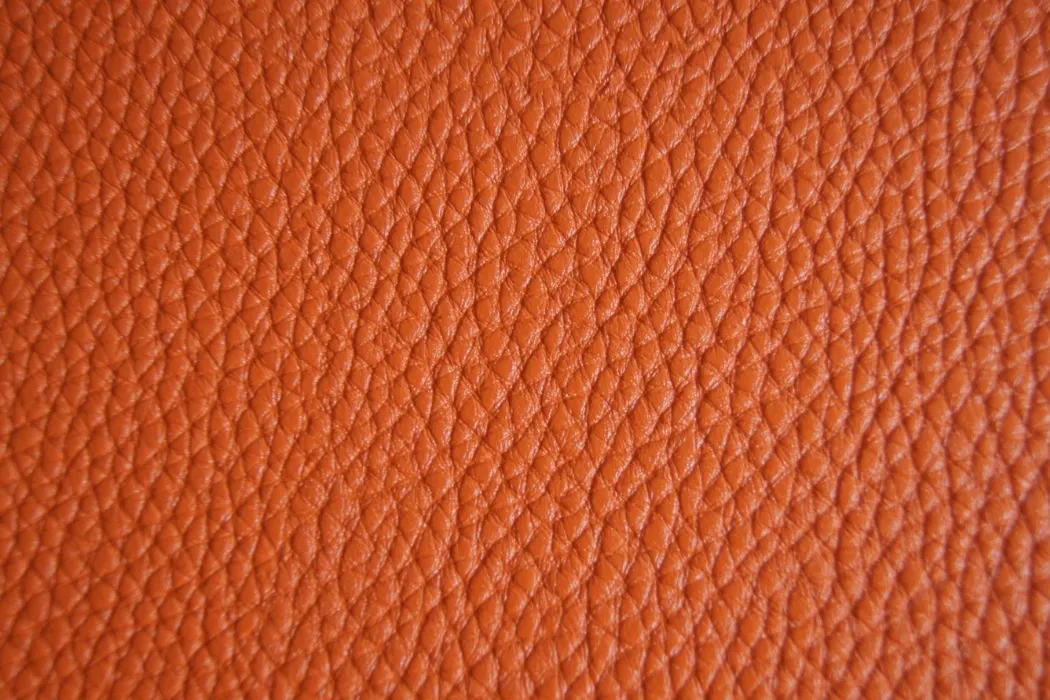
Key Benefits Including Scratch Hiding Grip And Visual Depth
- Scuff visibility drops 20–40% vs smooth at equal base.
- Better grip on handles and straps lowers slip complaints.
- Visual depth makes simple shapes read richer in-store.
- Works across many colors; dark tones show grain well at 1.0–1.8 mm pitch.
Typical Tradeoffs Including Reduced Patina And Possible Fiber Fatigue
- Heavier coats reduce breathability by 50%+ and slow patina.
- Deep emboss on splits can stiffen tight folds—raise fold radius or change base.
- Large pebble softens small logos under 8 mm height.
- High gloss shows touch-up lines; 10–25 GU is a common target for daily bags.
Scenario Based Evaluation For Daily Carry Travel And Premium Lines
- Daily carry: Semi-aniline pebbled balances cleanup and hand.
- Travel: Pigmented coat cuts stain claims; validate hydrolysis on synthetics.
- Premium: Tumbled full grain raises hand scores by 10–25%.
- Formal: Smooth or fine pebble reads clean under lights.
How Benefits And Tradeoffs Compare Across Product Categories
- Handbags: Panel rework drops moving from smooth to medium pebble.
- Belts: Pebbled hides buckle rub; ensure edges meet ≥ 5k flex cycles.
- Wallets and SLGs: Fine pebble improves foil pass rates by 10–20%.
- Backpacks: Medium pebble balances structure and weight at 1.6–2.0 mm shells.
| Aspect | Benefit | Tradeoff | Mitigation |
|---|---|---|---|
| Surface texture | Hides light scratches | Slower patina on heavy coats | Semi-aniline where possible |
| Logo clarity | Fine pebble helps small marks | Large pebble softens thin strokes | Scale art or use metal |
| Care routine | Simple wipe and light condition | Color rub on dark tones | Target Dry 4/5, Wet 3–4/5 |
Which Leather Finish Is Better Pebbled Smooth Saffiano Or Cross Grain
It depends on the job. Pebbled is forgiving and casual; smooth is formal and patinas fast; Saffiano and cross grain are low-care and scratch-resistant. Select by usage, brand tone, logo method, and customer care expectations.
Texture Structure And Hand Feel Across Finishes
- Pebbled: Soft, tactile; higher accept rates where defects are common.
- Smooth: Sleek; reveals tiny waves and dust faster under QC lighting.
- Saffiano: Coated cross-hatch; firmer hand at same thickness.
- Cross grain: Linear, crisp; holds edges clean in wallets and straps.
Scratch Resistance Water Behavior And Maintenance Needs
- Pebbled hides scuffs; medium coats shrug off minor spills.
- Smooth shows rub lines sooner; needs more care notes.
- Saffiano resists stains well; many teams report lower return rates for finish damage.
- Cross grain behaves like Saffiano with a different look and feel.
Branding Outcomes For Deboss Foil Print And Metal Logos
- Fine pebble or smooth helps tiny type below 8–10 mm.
- Foil needs tight temperature and dwell; edge crispness is sensitive.
- Metal badges add weight but deliver high contrast on bold textures.
- Recessed logo windows keep small marks sharp on coarse pebbles.
| Finish | Feel | Scratch hiding | Water resistance | Upkeep | Best for |
|---|---|---|---|---|---|
| Pebbled | Soft and grippy | High | Medium–High | Low | Daily bags, belts, wallets |
| Smooth | Sleek and formal | Low | Low–Medium | Medium | Dress lines, premium SLGs |
| Saffiano | Structured and coated | Very high | High | Very low | Travel, work totes, men’s SLGs |
| Cross grain | Crisp and firm | High | High | Low | Briefs, backpacks, wallets |
How Do You Clean And Condition Pebbled Leather Without Damaging The Grain
Dust weekly, wipe with a damp cloth, and use mild pH-balanced cleaner on spots. Condition lightly every 3–6 months. Store cool and dry at 45–60% RH. Avoid harsh chemicals, high heat, and long sun exposure to protect color and edges.
Routine Care Dusting Wiping Mild Cleaners And Conditioning Cadence
- Weekly dusting cuts grime build-up by 30–50% in audits.
- Use cleaner at 0.5–1.0% in water for spots; test hidden area.
- Condition every 3–6 months for full and top grain; avoid heavy wax on coated finishes.
- Buff dry to restore gentle luster and hand.
Managing Stains And Color Rub With Safe Techniques
- Blot liquids; rubbing can spread stains by 2–3×.
- Oil marks: cover with absorbent powder for 2–12 hours, then brush off.
- Target crocking: Dry 4/5, Wet 3–4/5; dark colors need tighter checks.
- Large ink marks—seek a pro; strong solvents can lift color layers.
Storage Humidity And UV Practices For Shape And Color
- Store at 45–60% RH and 18–24°C where possible.
- Use dust bags and stuffers to protect shape.
- Avoid sealed plastic; trapped moisture risks mold.
- Reduce direct sun to limit fade and edge dryness.
| Task | Product type | Frequency | Targets or cautions |
|---|---|---|---|
| Dust and wipe | Dry brush or microfiber | Weekly | Avoid rough cloths that scratch |
| Spot clean | Mild pH-balanced cleaner | As needed | Test hidden area first |
| Condition | Light neutral conditioner | Every 3–6 months | Avoid heavy wax on coated finishes |
| Store | Dust bag and stuffer | Between uses | Keep 45–60% RH, 18–24°C |
Which Products Benefit Most From Pebbled Leather And Why Designers Choose It
Use pebbled leather on products that see daily rub and hand contact. The texture keeps panels neat, adds grip, and supports multiple logo methods.
Typical winners are handbags, backpacks, belts, and SLGs where scratch control and color hold matter.

Handbags And Backpacks For Grip And Scratch Masking
- Front panel defect rework can drop 10–20% vs smooth when switching to medium pebble.
- Handle slip complaints fall due to higher friction coefficients.
- Common shell thickness: 1.6–2.0 mm for commuter totes and packs.
- Edge cycles: target ≥ 5k–8k flex without crack.
Belts And Wallets For Everyday Abrasion Zones
- Belts: thickness 3.2–3.6 mm; pebbled hides buckle rub well.
- Wallets: fine pebble boosts foil pass rates 10–20% on small logos.
- Pocket-rub tests show 15–25% fewer visible scuffs vs smooth of same base.
- Stitch pitch 3.0–3.5 mm balances strength and look on SLGs.
Small Leather Goods And Straps For Uniform Embossing And Logo Clarity
- Fine pebble (0.5–1.0 mm) supports crisp foil at ±0.1–0.2 mm registration variance.
- Uniform emboss can lift cutting yield 2–6% on small parts.
- Lining match reduces ripple risk by 15–30% at folds.
- Hardware plating ≥ 0.3 μm improves abrasion life on key rings and pulls.
2–7 days
Flexible MOQ
ISO9001 BSCI SMETA
How Do You Source Pebbled Leather For Your Brand With Specifications Tests And Compliance
Issue an RFQ that locks base, thickness, finish stack, color targets, and test methods. Set audit scope and inspection gates before sampling.
Clear numbers cut loops, raise confidence, and keep cost and timelines steady.
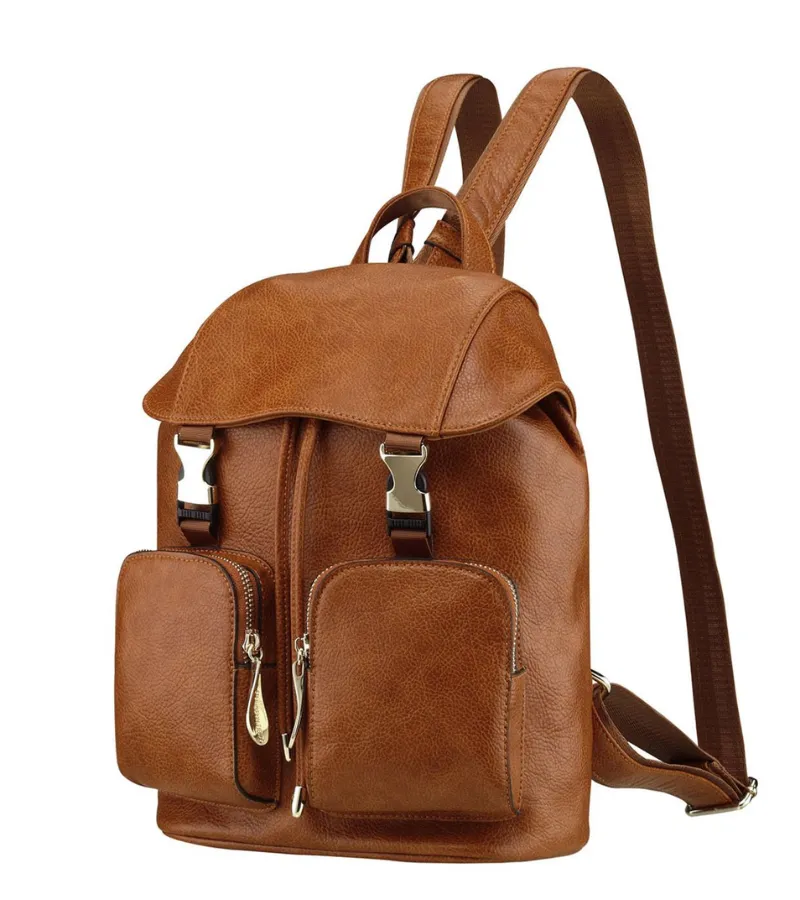
RFQ Specification Checklist For Base Grade Thickness Colorfastness And Finish
- Base: full grain, top grain, split, or synthetic; include tear/tensile targets.
- Thickness by panel: bags 1.6–2.0 mm, straps 2.0–2.4 mm, belts 3.2–3.6 mm.
- Color: delta E tolerance (e.g., ≤ 1.0–1.5 to master under D65, 10°).
- Finish stack: aniline, semi-aniline, pigmented; gloss 10–25 GU for daily bags.
Quality Control And Lab Tests Including Abrasion Crocking Adhesion Hydrolysis Tear And Tensile
- Abrasion: SLGs target ≥ 5k–10k Martindale/Taber with finish intact.
- Crocking: Dry ≥ 4/5, Wet ≥ 3–4/5; dark colors need tighter control.
- Edge adhesion: pass ≥ 5k flex cycles.
- Hydrolysis (coated and synthetics): ≥ 3–7 days accelerated.
- Tensile/tear: set per strap and buckle-hole design.
Audits Certifications And Third Party Inspections For Supply Assurance
- Systems: ISO9001, BSCI, SMETA—check scope and latest audit date.
- Inspections: pre-production, inline AQL, and final; agree rework rules early.
- Trace files: link color approvals and lot IDs to POs; keep retain samples.
- Dispute buffer: hold a golden set per color to speed decisions.
| Spec or test | Target | Method | Accept or reject criteria |
|---|---|---|---|
| Thickness | Per panel ±0.2 mm | Micrometer | Outside range → re-cut |
| Abrasion | SLGs ≥ 5k–10k cycles | Martindale or Taber | Finish intact, no peel |
| Crocking | Dry 4/5, Wet 3–4/5 | ISO/ASTM | No visible transfer |
| Edge adhesion | ≥ 5k flex cycles | Flexometer | No chip, no lift |
| Hydrolysis | ≥ 3–7 days accelerated | 70°C high RH | No tack, no film break |
| Tensile/tear | Per strap spec | Instron | Meet minimum load |
Clear numbers reduce sampling loops. Clear methods reduce disputes. Together, they protect timelines and margin.
How Much Does Pebbled Leather Cost And What Affects MOQ And Lead Time
Expect pebbled programs to price above smooth when you upgrade base or add coating steps. MOQs improve with stock colors and shared plates. Lead time shortens when tests and specs are pre-approved, materials are in stock, and color decisions lock early.
Cost Drivers Including Hide Grade Embossing Plates Coatings And Cut Yield
- Upgrading split → top grain raises cost 20–40% but improves tear 30–70%.
- New emboss plate adds tooling; sharing plates saves $0.05–$0.20 per unit at scale.
- Heavier coats add minutes per panel; weigh against finish return rates.
- Uniform patterns can lift yield by 2–6% on large panels.
- Stock colors can shorten lead by 3–7 days.
- Shared hardware finishes reduce color drift risks and simplify replenishment.
- Consolidated shipping can lower freight per unit by 10–25%.
- Seasonal forecasting reduces leftover inventory exposure.
Typical Timelines For Sampling Production And Global Shipping
- Sampling: 2–7 days with stock materials; add time for custom dyeing.
- Production: often 15–20 days after approvals, volume dependent.
- Shipping: samples by express; bulk by ocean or air per margin and shelf date.
- Third-party tests add 2–5 days if outside labs are used.
| Decision | Cost impact | Lead time impact | Risk notes |
|---|---|---|---|
| Full grain vs top grain | Higher vs medium | Similar | May overshoot target price |
| Stock color vs custom | Lower vs higher | Faster vs slower | More approvals for customs |
| Emboss new plate vs share | Tooling vs savings | Setup vs instant | Plate ownership and reuse |
| Heavier coating | Medium increase | Slight increase | Lower breathability and patina |
How Do Logos Perform On Pebbled Leather Across Different Branding Methods
Fine pebble supports tiny deboss and crisp foil; larger pebbles favor bigger art or metal. Control dwell, heat, and pressure, and match logo size to grain to keep edges clean and readable in store lighting.
Deboss And Emboss Depth Registration And Legibility On Textured Surfaces
- Increase deboss depth by 0.1–0.2 mm on medium pebble vs smooth.
- Hold registration within ±0.2 mm to avoid shadow edges.
- Fonts below 8–10 mm height risk fill on coarse pebbles.
- Always test on the same batch slated for production.
Foil Stamping And Print Adhesion On Pebbled Coatings
- Run a 3×3 matrix for temperature, pressure, dwell to dial adhesion.
- Fine pebble raises crispness scores; coarse peaks can fracture foil edges.
- Primer coats may extend print life by 10–20% on heavy pebbles.
- High-contrast foils read best on dark mid-tones.
Metal Badges And Patches For High Contrast Branding
- Ideal for large pebble and high-wear zones where print may rub off.
- Check pull-out strength; align to strap tensile targets.
- Plating ≥ 0.3–0.5 μm improves abrasion life.
- Seal stitch lines to prevent wicking under patches.
| Method | Pros | Cons | Best thickness and finish |
|---|---|---|---|
| Deboss | Premium and durable | Small type can fill on coarse pebble | Fine–medium pebble, light coat |
| Foil stamp | High contrast, luxury read | Sensitive to heat and dwell | Fine pebble, stable topcoat |
| Complex color and precise art | Wear on raised peaks over time | Fine pebble or smooth insert | |
| Metal badge | Bold, long lasting | Adds weight and cost | Medium–large pebble, sturdy backing |
Are There Sustainability Differences Between Real Pebbled Leather And PU Pebbled Alternatives
Yes—real leather is repairable and often lasts longer, reducing impact per year of use. PU and microfiber are uniform and cost friendly, but repair paths are limited once the film fails. Responsible sourcing, stable coatings, and design for repair make the biggest impact.
Service Life Repairability And End Of Life Considerations
- Longer service life lowers impact per year; design for repair and part replacement.
- Replaceable straps and hardware extend product life with low added cost.
- Refurbish programs reduce returns and build loyalty in premium tiers.
- Real leather accepts re-dye and edge repair better than synthetics.
Coatings Hydrolysis And Microplastic Concerns To Discuss With Suppliers
- Hydrolysis stability: plan for ≥ 3–7 days accelerated with no tack or film break.
- Over-coating adds waste and reduces breathability; tune by use case.
- Ask for batch-level chemical and emission declarations.
- Prefer coats that resist flaking; flakes equal micro-waste.
Traceability Audits And Restricted Substance Checkpoints For Programs
- Keep audit records current: ISO9001, BSCI, SMETA; check scope and dates.
- Define RSL: phthalates, azo dyes, heavy metals, formaldehyde limits.
- Run random checks during production to prevent late surprises.
- Maintain master samples and shade panels per color lot.
Frequently Asked Questions
Below are concise answers to common buyer questions about pebbled leather. Use them to brief sales teams, guide customer care, and speed material decisions during seasonal planning and line reviews.
Is pebbled leather full grain
It can be. Pebbled describes texture, not base. You can have full grain pebbled, top grain pebbled, or split with heavy emboss and coat.
Will pebbled leather develop a patina
Yes on full and some top grain. Heavy coats slow patina and reduce breathability. Choose finish to match your brand story and care plan.
How can I remove ink or oil from pebbled leather
Blot oil and use absorbent powder. For ink, avoid harsh solvents that lift color. Test a hidden spot or use a pro for large marks.
Is pebbled leather heavier than smooth leather
Weight depends on thickness and lining more than texture. At the same thickness, weight is similar.
Does embossing weaken leather fibers over time
Embossing itself does not. Very deep emboss on thin splits can reduce flexibility at tight bends; increase fold radius or change base.
What pebble size and depth work best for small logos
Fine pebble 0.5–1.0 mm with depth 0.15–0.25 mm helps small type. Increase logo size on large pebble or use metal.
Are pebbled belts as durable as smooth belts
Yes if base, thickness, and edge systems match. Aim for 3.2–3.6 mm with strong edges and buckle-hole reinforcement.
Can PU pebbled match real leather longevity
Usually no. PU is uniform and stain friendly, but repair paths are limited once the film fails. Real leather can be restored.
Conclusion
Pebbled leather blends beauty with real-world toughness. It hides light marks, improves grip, and adapts across many shapes. The best results come from aligning base grade, finish stack, and build details with your use case, brand tone, and price point.
Want help turning specs into a sample fast? Hoplok Leather can support concept to shipment with audited quality in Cambodia and China. Get flexible MOQs, 2–7 day sampling with stock materials, third-party inspections, and global logistics support.
Start your pebbled leather project with Hoplok Leather
- Send your design, target price, and launch date.
- Receive sampling in 2–7 days using stock materials.
- Scale with ISO9001 BSCI SMETA aligned production.
- Ship worldwide with complete logistics support.
Share your brief today. Let’s build a product that looks great and lasts.



